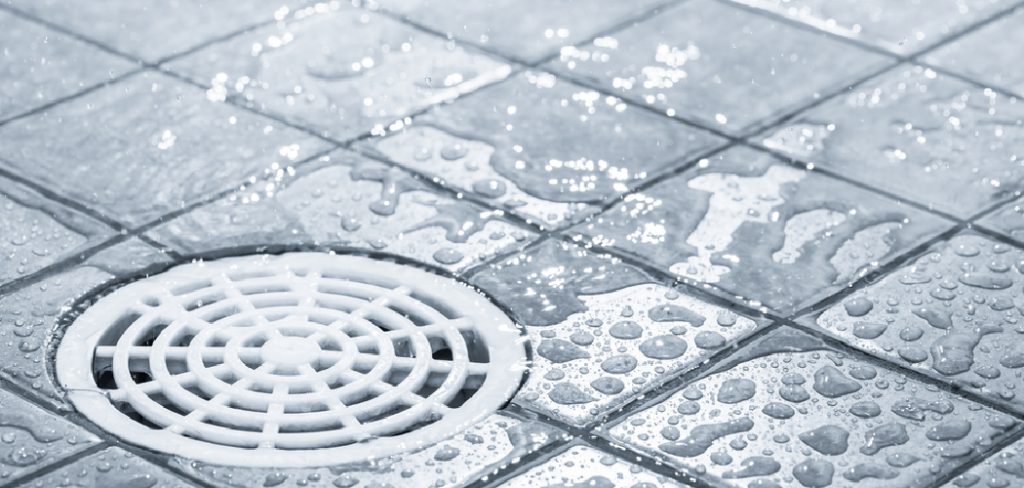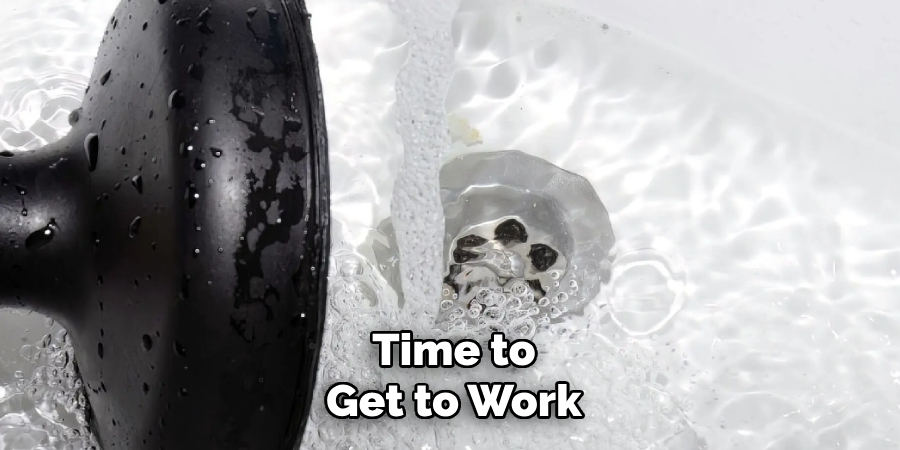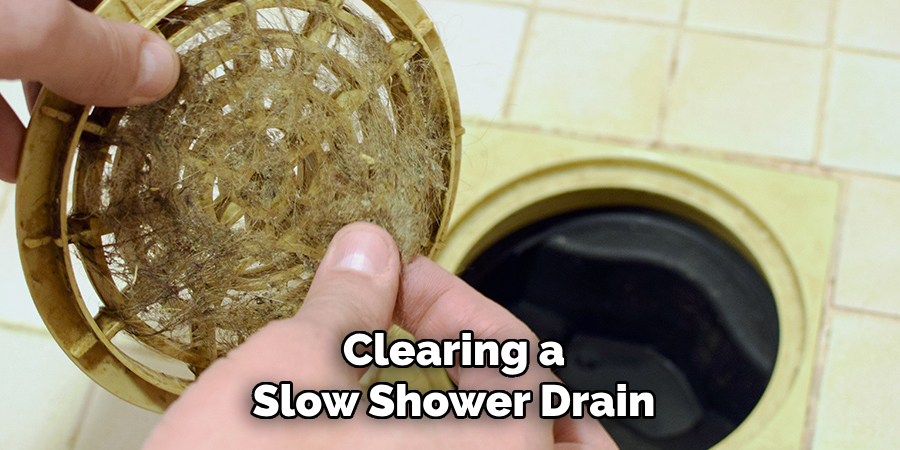Are you tired of standing in a pool of water while showering? Do you constantly wait for the water to drain before getting out?
A slow drain can quickly turn an enjoyable shower into a frustrating experience as water pools around your feet. Over time, drains often become clogged with soap scum, hair, and other debris, restricting the flow of water.
Fortunately, addressing this common household issue doesn’t always require a professional plumber. With the right tools and know-how, you can restore your shower drain’s efficiency and prevent future blockages.

This guide on how to speed up a slow shower drain will walk you through simple and effective steps to speed up a slow shower drain, ensuring a smooth and hassle-free shower experience.
What Are the Benefits of a Fast-Draining Shower?
Before diving into the steps to speed up a slow shower drain, let’s first understand why having a fast-draining shower is essential.
- Better Hygiene: Stagnant water can breed bacteria and cause unpleasant odors. Ensuring your shower drains quickly reduces the chances of bacteria growth and keeps your shower area clean and hygienic.
- Faster Showers: With a fast-draining shower, you don’t have to wait for the water to drain slowly before getting out. This saves time and makes your morning routine more efficient.
- Prevents Clogs: A slow shower drain is often an early sign of potential clogs in your plumbing system. By promptly addressing the issue, you can avoid major blockages and costly repairs.
Now that we understand the benefits of a fast-draining shower let’s move on to how we can achieve it.
What Will You Need?
To speed up a slow shower drain, you will need the following tools:
- Plunger: A plunger is an essential tool for clearing clogs in drains. It uses pressure and suction to dislodge debris and allow water to flow freely.
- Drain Snake: A drain snake, also known as a plumber’s auger, is a long, flexible tool with a coiled end to remove obstructions from pipes.
- Baking Soda and Vinegar: These everyday household items can be used as natural cleaners to dissolve buildup and clear minor blockages in drains.
Once these tools are ready, it’s time to get to work.

9 Easy Steps on How to Speed Up a Slow Shower Drain
Step 1: Remove Visible Debris
Begin by inspecting the shower drain for any visible debris causing the blockage. Hair, soap scum, and small particles often accumulate near the surface and are easy to remove by hand. It’s a good idea to wear gloves during this step to maintain hygiene and avoid contact with potentially unpleasant materials.
Use a flashlight if necessary to get a clearer view of the drain interior. Removing this surface-level clog ensures that the following steps target deeper obstructions effectively, giving you a better chance of restoring the water flow.
Step 2: Pour Boiling Water Down the Drain
Once you’ve removed any visible debris, heat a pot of water until it reaches boiling. Carefully pour the boiling water directly down the drain, allowing it to work its way through any soap scum or grease buildup that might be contributing to the blockage. Be sure to pour slowly to prevent splashing, and repeat this process if necessary. This simple step can help dislodge minor clogs and improve the drain’s flow.
Step 3: Use Baking Soda and Vinegar
After tackling the clog with boiling water, the next step is to use a natural cleaning solution made from baking soda and vinegar. Start by pouring half a cup of baking soda down the drain, ensuring it reaches as far as possible into the pipe. Follow this with half a cup of white vinegar.
A fizzing reaction will occur, which helps to break down stubborn buildup like grease, soap residue, and organic materials. Allow the mixture to sit for 15-20 minutes to maximize its cleaning power.
Once the time has passed, flush the drain with hot water to wash away the loosened debris. This eco-friendly solution is highly effective for addressing more challenging clogs without using harsh chemicals.
Step 4: Use a Plunger
If the drain is still clogged after trying the previous methods, it’s time to use a plunger. Place the plunger over the drain, ensuring a tight seal, and begin plunging with an up-and-down motion.
The pressure created helps to dislodge any remaining blockage within the pipes. For best results, add enough water to the sink or tub to cover the plunger’s rim, which helps improve suction.

After a minute or two of plunging, test the drain to see if the clog has cleared. If necessary, repeat the process until the water flows freely.
Step 5: Try a Drain Snake
If the clog persists despite previous efforts, a drain snake or plumber’s auger can be a helpful tool. Insert the snake into the drain and slowly turn the handle to work it through the pipes. This tool is designed to reach deep blockages and break them apart or pull them out.
Once the obstruction has been removed, run hot water through the drain to ensure it is completely clear. This method is particularly effective for stubborn clogs that are difficult to reach with other techniques.
Step 6: Call a Professional Plumber
If all else fails and the drain remains clogged, it may be time to call a professional plumber. Some blockages are caused by issues deep within the plumbing system, such as tree roots or damaged pipes, requiring specialized equipment and expertise.
A licensed plumber can identify and resolve the problem efficiently, ensuring your plumbing is restored to full functionality. It’s important to seek professional help if you suspect a severe issue to avoid causing further damage to your pipes.
Step 7: Prevent Future Clogs
To avoid future clogs, adopt regular maintenance practices for your drains. Use drain strainers to catch hair, food particles, and debris before they enter your pipes. Avoid pouring grease, oil, or large food scraps down the drain, as these can accumulate and cause blockages over time.
Periodically flush your drains with hot water and vinegar or a gentle enzyme-based cleaner to break down potential buildup. By implementing these preventive measures, you can maintain clear and functional plumbing while reducing the likelihood of future clogs.
Step 8: Keep an Eye on Your Water Flow
Even after clearing a slow shower drain, monitoring the water flow is essential. If your drain is slowing down again, address the issue immediately. It’s always easier to clear minor clogs before they become significant blockages. Regularly inspecting and cleaning your drains can also help identify potential issues early on and save you from costly repairs.
Step 9: Use Hair Catchers
Hair catchers are simple, inexpensive tools that significantly reduce the amount of hair entering your drains. They come in various designs, including mesh strainers, silicone barriers, and over-the-drain covers, making them versatile and easy to use for different drains.
Place a hair catcher over your shower or bathtub drain to trap loose hair before it can wash down and cause a clog. Clean the hair catcher regularly by removing the trapped hair and rinsing it thoroughly to maintain its effectiveness.

By following these steps and incorporating preventive measures, you can effectively clean and maintain your shower drain, ensuring it remains clog-free.
5 Things You Should Avoid
- Using Harsh Chemical Drain Cleaners: While chemical drain cleaners may provide a quick fix, they can cause long-term damage to your pipes. The corrosive nature of these chemicals can erode the pipes over time, leading to leaks or more severe issues.
- Ignoring the Problem: A slow shower drain won’t fix itself, and waiting too long can turn a minor inconvenience into a significant blockage. Ignoring the issue can also lead to unpleasant odors, water pooling, and even water damage to your bathroom.
- Flushing Non-Dissolvable Materials Down the Drain: Avoid letting items like hair, soap scum, or small objects go down the drain, as they can accumulate and create stubborn blockages. Always use a drain cover or strainer to catch debris before it can clog your pipes.
- Using Improper Tools: Attempting to clear a drain with improper tools, such as wire hangers or unapproved plumbing devices, can damage your pipes or push the clog further down. Stick to recommended tools like a plumbing snake or plungers specifically designed for drains.
- Overlooking Regular Maintenance: If you don’t clean your drain regularly, buildup from soap, hair, and hard water deposits can cause slow drainage. Maintenance, like using a natural drain cleaner monthly and cleaning drain covers, helps prevent clogs and keeps water flowing smoothly.

Conclusion
To speed up a slow shower drain, adopting good habits and proper maintenance techniques is vital.
Start by addressing existing clogs with safe and effective tools or cleaners, such as a plumbing snake or a biodegradable drain cleaner. Prevent future blockages by using a drain cover to catch hair and debris and regularly cleaning the cover and surrounding area.
Avoid flushing non-dissolvable materials down the drain, and be cautious about the tools you use for troubleshooting to avoid pipe damage. Finally, establish a routine for maintaining your drain to ensure it stays clear and functional.
By following these simple steps on how to speed up a slow shower drain, you can keep your shower drain flowing efficiently and avoid costly repairs in the future.

